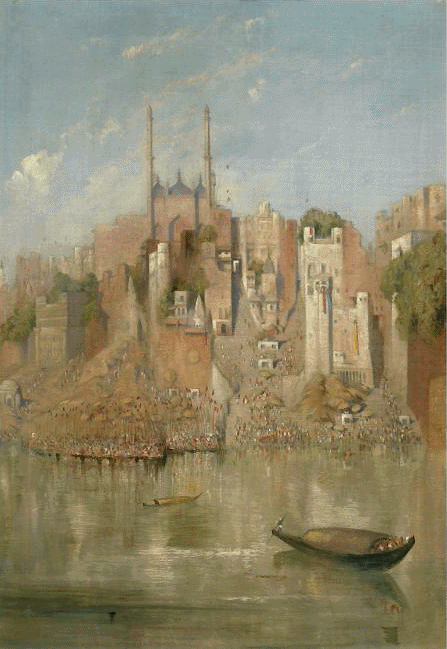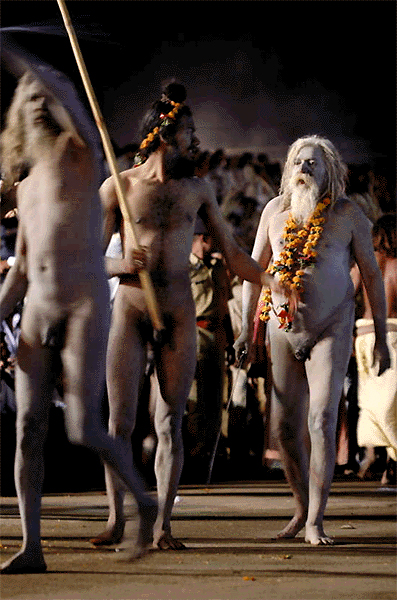
|
|
|
|
BY: SUN STAFF

The Mahomeden Temple at Bissasir Ghat, Benares Jun 17, 2010 — CANADA (SUN) — A serial presentation of the Mughal effect on Vaisnava society. In our last segment of this series, we talked about Emperor Akbar's intervention in a dispute between groups of ascetics who had gathered to bathe in the holy tank at Thaneswar (Kurukshetra). Several versions of the story exist, as it was told by Akbar's court historians and as it was passed down through oral tradition amongst the sannyasis themselves.
According to the latter account, Madhusudana Sarasvati from Benaras, a prominent sannyasi scholar of the Sarasvati Dasnamis, is said to have met with Akbar, seeking his intervention in the ongoing fratricidal disputes amongst the groups of sadhus. Akbar reportedly agreed that the sannyasis should take up arms to protect themselves, so Madhusudana arranged for large numbers of Ksatriyas and Vaisyas to be initiated into the Dasnami sannyasa lineages. The sannyasis' oral tradition version of this story about Akbar's influence on the Hindu ascetic community was corroborated by two later accounts: one by a government official who conducted an inquiry into the Allahabad Kumbha Mela disaster that had taken place a year earlier, and another by a team of anthropologists who in 1970, were conducting research at the sannyasis' mathas in Banaras. The government inquiry reported that: "Madhusudan Saraswati Ji of Banaras, possibly with the assistance of Birbal and Abdul Rahim Khankhana, the well known Ministers of Emperor Akbar, and with the approval of the Emperor, had put the organization of these Akharas on proper footing." Twenty years later, another version of the story was collected from the ascetics of the Juna akhara (matha) in Benares: "From ancient times the Naga ascetics were peregrinating in the country in groups, called Jhunti. During the reign of Akbar, the Moslem Malanga faquirs were troubling the Hindu villagers, because the Hindus used to receive the Naga sannyasis respectfully, while the Malanga faquirs were more feared than respected. This eventually exploded into an open clash between the Nagas and the Malangas. The Malangas were already equipped with swords, they killed the Naga ascetics mercilessly. When the Hindus approached Akbar for justice, the latter said: two cows are fighting, which indicated his helplessness or non-interference in this religious matter. On this the princes of Rajputana sent some soldiers in the guise of ascetics to defend the Hindu sannyasis and villagers from the ravages of the Malanga faquirs. [According to Mughal accounts, Akbar ordered some of his foot soldiers to smear themselves with ash and enter the battle, on the side of the sannyasis.] It was on this occasion that for the first time, the Naga ascetics were supplied with arms by Hindu kings. These ascetics gradually trained themselves in fighting, and subsequently fought many battles and took part in many a skirmish." 
Maharana Pratap (1542-1597) Descendents of the fierce Nagas described here are visible to this day, known for their appearances at Khumba Melas, where they continue to brandish weapons and express a stern, if not threatening warrior-like presence. In his book, Warrior Ascetics and Indian Empires, author William R. Pinch describes how Akbar's intervention with the sannyasis at Thaneswar eventually impacted many branches of India's religious movements, beginning with the Saivites. He writes: "Taken together with Farquhar's 1925 account, all three oral traditions make the assertion that the imperial intervention was in some way instrumental in ascetic military organization and institutionalization. This is probably the most important historical assertion that can be made about the interaction between Akbar and Hindu ascetics. It speaks not simply of a sequence of events, but of long-term change – the meat and potatoes of the historical profession. The fact that it is not transmitted in the Mughal record is not surprising: the broader implications of Akbar's decision to intervene in the affairs of Hindu ascetics would probably not be felt for some time, if they were felt at all, and certainly would not be the concern to Mughal chroniclers intent to record for posterity the emperor's doings. Of course, the oral tradition may have been asserting rather than recording a link between institutional transformation and the agency of Akbar. Nevertheless, there are several possibilities as to the nature of the transformation, whether or not Akbar was the cause of it. The 1925, 1954, and 1978 versions of the oral tradition were told from, as Farquhar put it, "the lips of sannyasis," and were given as an explanation for how it was that large numbers of armed men populated the lower ranks of India's largest ascetic order, the Dasnami, who claim descent from the ninth-century sage, Shankaracharya. We may conclude then, that the various Dasnami sannyasis interviewed in the twentieth century were (or at least saw themselves as) the institutional descendants of the sannyasi victors at Thaneswar in 1567. Pinning a firm institutional identity to their yogi adversaries is, by contrast, more difficult. The term yogi today usually refers to ascetics who claim descent from the ninth-century master, Gorakhnath. But as applied in the medieval and early modern periods, the term signified a loose band of ascetics connected with the emulation and worship of Bhairava, a form of Siva that haunts the cremation ground. As David White has noted in his study of the "nath siddha" tradition:

Naga Ascetics "'Yogi' or 'jogi' has, for at least eight hundred years, been an all-purpose term employed to designate those Saiva religious specialists whom orthodox Hindus have considered suspect, heterodox, and even heretical in their doctrine and practice. On the one hand, the Yogis are defined (like the tantrikas of an earlier time) by their nonconformity to and exclusion from orthodox categories: they are that troubling aggregate of sectarian groups and individuals whose language and behavior subvert the canons of Vedic, devotional, and 'high' tantric religion. On the other hand, they are defined by certain features of their sectarian affiliations and practices: heirs to the heterodox Pasupatas and Kapalikas of an earlier age, they are devotees of terrible forms of Siva (usually Bhairava) who besmear themselves with ashes, leave their hair uncut, and continue to adhere to the practices of 'primitive' tantrism. As such, their 'yoga' is more closely identified, in the jaundiced eyes of their critics, with black magic, sorcery, sexual perversion, and the subversion of alimentary prohibitions than with the practice of yoga in the conventional sense of the term." As members of the Gaudiya Vaisnava sampradaya, we are not so concerned with how Akbar's presence in North India impacted the Saivites, but are much more interested in the influence felt by the Vaisnava community. Akbar established his court at Galta (Golta), near Jaipur, which in the early 16th century had became an important northern center for the Ramanujacaryas. This was the place where the famous Gaudiya Vaisnava acarya, Sri Baladeva Vidyabhusana, delivered his Sri Govinda Bhasya to the Ramanandi scholars, in 1718 A.D. As this series unfolds, we'll attempt to trace the impact of Akbar's actions at Thaneswar into the Vaisnava movement, as it moved through the ranks of the Shankarites, and into the Ramanuja community.
| |